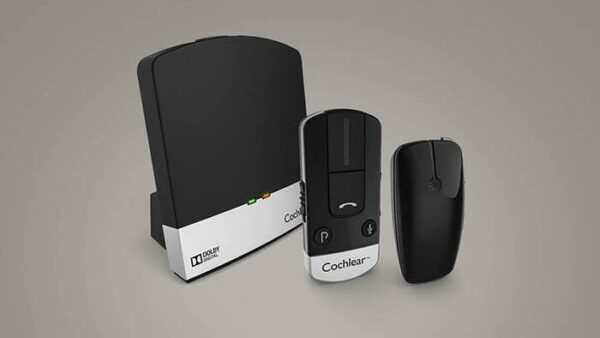Have you tried direct streaming audio with your Cochlear® sound processor? Many recipients tell us it helps them at work, school and more. Learn more about its proven benefits.
Do you use direct streaming with your Cochlear sound processor? Recipients often tell us they find it helps in many circumstances, including at work and at school – from joining work calls to watching videos.
Studies show that direct streaming is also proven to offer benefits in hearing with a sound processor.123 It can also help you enjoy more types of entertainment, work and school, and it can also support your efforts to improve your listening skills.
How direct streaming helps you hear more clearly
Much research has been done on how direct streaming can deliver benefits to those who use cochlear implants and hearing aids.4 But how does it really help? Essentially it comes down to two factors: Noise and distance.
Cutting through the noise
Direct streaming is all about delivering high quality sound straight to your sound processor from your compatible device. This means the audio signals are less influenced by the environment giving you a clearer, crisper listening experience.
For example, if you’re talking on the phone in a crowded place like a train station or on a bus, it can be hard to hear clearly. Direct streaming from a compatible smartphone5 would send the sound straight to your sound processor without the outside interference to help you hear the conversation clearly. One study found that recipients who used streaming to talk on the phone showed improved word recognition in quiet and in noise, compared to talking on the phone normally.6
Hear how Nancy benefits from direct streaming in her everyday life below.
Up close and personal
An important factor with hearing: As you move further away from a sound, the more the sound quality will drop off. When you use streaming to watch TV, listen to music, attend a lecture or a conference, you’ll hear more clearly than just using your sound processors alone. Streaming also allows you to hear at your own personal volume level. Being able to hear more easily in more situations can help you connect with friends and family more often socially, like movie nights at home.
Things to try with direct streaming

Here are three ideas for how you can try using direct streaming to your advantage.
- Expand your music appreciation skills
Direct streaming can be used to enjoy music, from attending concerts to playing instruments and singing. To start, create a playlist with a variety of music styles and listen to them regularly. Depending on your individual progress, start with simpler songs and tunes and gradually move to more complex music, trying to distinguish instruments and voices over time.
- Listen to audio books
Try listening to books and follow along with the printed text as well. By reading along, you’ll be able to pick up any words that were unclear or misheard. You can start with short or familiar books or stories, and gradually move to longer or more complicated plots as you improve.
- Practice on the phone
Talk to friends and family on phone calls or video calls using direct streaming to try and improve your ability to follow and engage in conversations. For video calls, start building your confidence by talking to a close friend or family member, then gradually increase the number of people you can communicate with for group video calls. These are just ideas to get you started, so feel free to adapt them to suit your listening skills. Practicing regularly is your best bet to see improvements. The availability of technology for direct streaming is going to evolve over time to include more devices and more opportunities for you to enjoy life with clearer sound.
New to direct streaming? See what devices are compatible to connect with Cochlear sound processors.
Learn more about True Wireless™ devices here.
- Wolfe J, et al. Evaluation of a wireless audio streaming accessory to improve mobile telephone performance of cochlear implant users. International Journal of Audiology. 2016;55(2):75-82.
- Wolfe J, et al. Improving hearing performance for cochlear implant recipients with use of a digital, wireless, remote-microphone, audio-streaming accessory. J Am Acad Audiol. 2015 Jun;26(6):532-9.
- Warren C, Nel E, and Boyd P. Controlled comparative clinical trial of hearing benefit outcomes for users of the Cochlear™ Nucleus® 7 Sound Processor with mobile connectivity. Cochlear Implants International (2019 Feb); 20(3).
- Jespersen, Charlotte T. “A review of wireless hearing aid advantages.” The Hearing Review, vol. 19, no. 2, Feb. 2012, pp. 48-54.
- For complete smartphone compatibility information, please visit www.cochlear.com/compatibility
- Wolfe J, et al. Evaluation of a wireless audio streaming accessory to improve mobile telephone performance of cochlear implant users. International Journal of Audiology. 2016;55(2):75-82.


